

This means Devi is the aspect of Brahma, while creating sristhi, aspect of Vishnu while sustaining sristhi, aspect of Rudra during dissolution sanghara. Srishti karthri brahma roopa gopthri-govinda-roopini samharini-rudrha-roopa thirodhanakareeswari sadashivaa-anugrahadha Pancha krithya parayana

Devi herself has been described as "pancha krtya parayana" in the sloka and the five tasks are described as follows: They are creation ( srishti), protection ( sthiti), destruction ( samharam), hiding ( thirudhanam) and blessing ( anugraham). There are basically five works ( pancha krtyam).

The slokas are organized in such a way that Devi is described from head to feet (kesadhi padham). An alternative origin is that the Upanishad Bramham Mutt at Kanchipuram is where this initiation happened. The temple at Thirumeyachur, near Kumbakonam, is said to be where Agastya was initiated into this sahasranama. At the request of Agasthya, Hayagriva is said to have taught him the thousand holiest names of Lalita.

Agasthya is one of the sages of yore and one of the stars of the constellation Saptarishi. Hayagriva is an incarnation of Vishnu with the head of a horse and is held to be the storehouse of knowledge. The text says that "One can worship Lalita only if she wishes us to do so." This stotra occurs in the Brahmanda Purana (history of the universe) in the chapter of discussion between Hayagriva and Sage Agasthya in Kanchipuram. Lalita Sahasranama is said to have been composed by the eight vaag devis (Vasini, Kameshvari, Aruna, Vimala, Jayani, Modini, Sarveshvari, and Kaulini) upon the command of the goddess Lalita herself. The Lalita Sahasranama does not use any such auxiliary conjunctions and is unique in being an enumeration of holy names that meets the metrical, poetical and mystic requirements of a sahasranama by their order throughout the text. Generally, sahasranamas use the artifice of adding words like tu, api, ca, and hi, which are conjunctions that do not necessarily add to the meaning of the name except in cases of interpretation. The Lalita Saharanama is one of the only sahasranamas that has exactly 1000 names without repetition. Therefore, the Sahasranama can be chanted in stotra form, or namavali form. The names are organized as hymns, or stotras, but are often broken into mantras to represent all 1000 names. Her thousand names use occasional wordplay. In its root form, the word Lalita means 'spontaneous' which is implicitly extended to 'play'. Etymologically, Lalita means 'She who plays'.


 0 kommentar(er)
0 kommentar(er)
